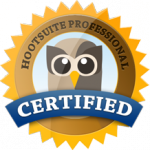This post may contain affiliate links. Please read my disclosure for details.
I love having guests come and talk to my class. Last week, Comm 322 Social Media had another special guest – Leigh-Anne Lawrence from Hagerstown Community College (HCC).
Leigh-Anne is the Social Media and Public Information Specialist in the Public Information & Government Relations Office at HCC. Among her many responsibilities, she is in charge of all the social media for HCC- namely, their Twitter, LinkedIn and Facebook.

A few cool highlights from Leigh-Anne’s presentation:
Leigh-Anne has helped build a university-wide social media policy to ensure communication consistency and reduce confusion among the public – For anyone thinking about creating a social media policy, particularly for higher ed, check out HCC’s guidelines. HCC’s policy will do more than just help govern what is appropriate and how entities should communicate on social media. At many universities, social media is decentralized leading to communication inconsistency. There are too many accounts (many of which become ghost towns). This leaves students confused as to which accounts to follow and how to get important updates. Leigh-Anne takes a proactive role in preventing this problem by seeking to consolidate the voice of HCC on social media. This helps make things simple for HCC followers. She does this in part by reaching out to people who have created social media accounts at HCC and seeking to route their messages through the main account. Leigh-Anne told us that sometimes units within the university will create an account but the folks behind it may not be too certain as to what they want to communicate or how best to go about using the social media service. One thing she’ll do is monitor how active these HCC-related accounts are. For example, if, say, the dining services starts its own Twitter account and doesn’t use it very often, Leigh-Anne may ask dining services if they wouldn’t mind handing over to her the burden of getting dining services’ content out to the HCC community. Whenever the dining services wants to get a message out, they can send it to Leigh-Anne. She’ll post it on HCC Twitter and Facebook. That takes the pressure of having to maintain the account off dining services and helps meet Leigh-Anne’s mission.
Note: You can see her white paper highlighting her research on social media usage at community colleges.
Always On – Leigh-Anne told us how social media workers must be “always on.” There are no days where one can truly log off – workers must keep an eye on social media whether it is the weekend or a vacation day.
Social Media and School Closings – A quick anecdote for those who, like me, loved it when school was closed as a child and wait, wait, waited by the TV watching the ticker of schools that were closed and hoping to see their school’s name on the list. Today, people not only call into the school to complain when the school is or isn’t closed, they take to social media. Leigh-Anne told us she gets up at 4am when there is a storm, awaits the word on whether the school is closed, and spends the rest of her morning until she reports to work fielding questions and responding to complaints, including through social media. She may also find herself spending several hours continuing to answer questions after she gets to work.
Introverts can work in PR – I love this! Leigh-Anne explained that you don’t have to be outgoing to thrive in the field. Introverts thrive “behind the scenes” where their great writing, web, photography, organizational, and numerous other skills are highly valued.
Leigh-Anne was kind enough to share her slides, which I’ve embedded from her SlideShare account below.
Thanks again to Leigh-Anne for sharing her experience and her expertise with us! You can find her @writenowsoical or her website.




